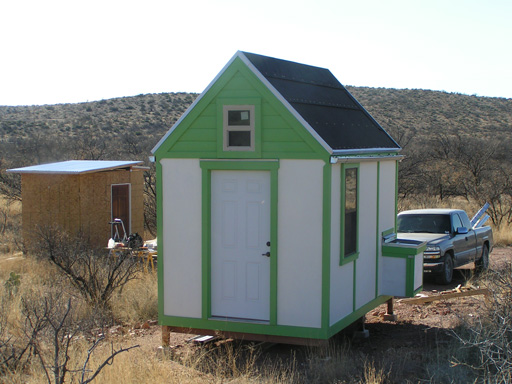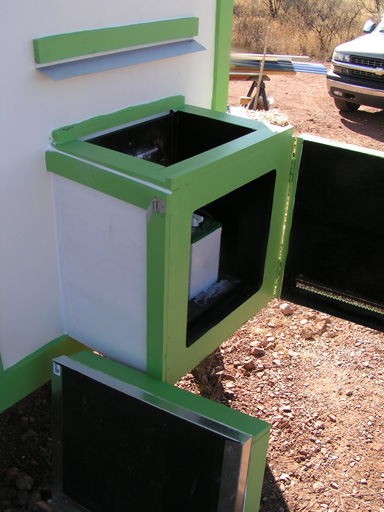I got the solar electric system installed in our cottage (we call it the Pumphouse, since on our site plan it is identified as a pumphouse, but presently it has no water anywhere near it).
Here are some pictures:

This is the cottage, viewed from the south. I put the solar panel on the roof as you can see. Our latitude is about 31 degrees and the roof angle is 45 degrees, so I'm really optimizing for winter sun. I don't know if that's what is best but I guess I'll find out. The solar panel is a 54-watt Kyocera and it really charges the batteries well.

Here is the control board. On top is a 20-amp charge controller, with a blade-type fuse on the positive line to the battery. The metal electrical box just houses the wire nut connection for the positive wire. The blue thing is a pure-sine wave inverter. I'm planning tidying this up and enclosing it in a box. We have an inquisitive toddler who will be sleeping nearby. I'd also like to install some sort of volt meter so I have a better idea how the batteries are doing without opening the box.

Here is the battery box, attached to the north side of the cottage. I'm really proud of this part. It is made from 99% recycled material or material found on hand (leftover scraps from other projects). My employer had bought new server equipment that came in a stain-grade plywood box. I took the box thinking I could make a router table out of it, but when I got bit by the solar bug there was only one thing for it: battery box!

I used scrap insulation, plywood, and cement board to convert it into a super-insulated, sealed box. It uses convection ventilation, with an air intake at the bottom of the door (screened to prevent insect or rodent entry) and a continuous ridge vent at the top. There is a lockable, hinged access door on the front and the "roof" is removable to make it easier to see how well the electrolyte is covering the plates. All surfaces inside are coated with roll-on bedliner stuff; the guy who sold me the batteries recommended it as it prevents any spilled electrolyte from eating through the box.

The batteries are 225Ah golf-cart batteries bought refurbished at $45 each. There is a 120-Amp fuse on the positive inverter cable. I think I spent $30 or less on the battery box, which was for the can of roll-on bed liner, the hasp, and the hinges for the door.
I plan to devise a way to prevent any hydrogen gas from drifting into the cottage through the opening for the cables. Probably some plastic conduit with an LB on the inside of the cottage, angled downward. I might run that conduit into a service panel with disconnects for all the lines going in or out of the battery box.
Overall I'm pretty satisfied with this system. I can charge all my cordless tools with it and still have enough power to run lights for several hours a night. Granted that's just weekend use; I couldn't do that all week. The solar panel is too small to keep up with that.